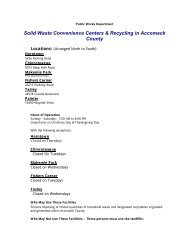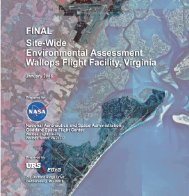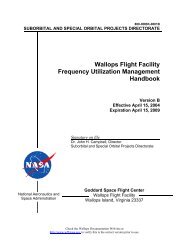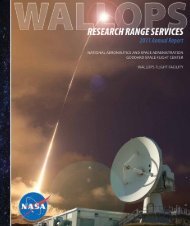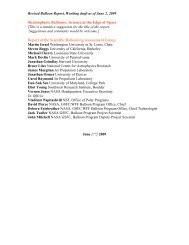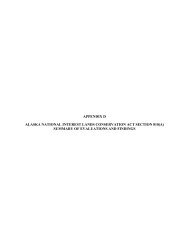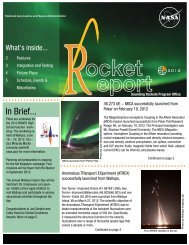Alternative Energy Draft EA - NASA Visitor Center at Wallops Flight ...
Alternative Energy Draft EA - NASA Visitor Center at Wallops Flight ...
Alternative Energy Draft EA - NASA Visitor Center at Wallops Flight ...
Create successful ePaper yourself
Turn your PDF publications into a flip-book with our unique Google optimized e-Paper software.
Environmental Consequences<br />
of magnitude) simply because their height (typically 150 meters [500 feet] and taller) is within<br />
the preferred zone of migr<strong>at</strong>ion, their guy wires cre<strong>at</strong>e additional collision hazards and steadyburning<br />
lights serve as an <strong>at</strong>tractant (Kerlinger et al., 2009, in review).<br />
The level of mortality documented for the WFF site is somewh<strong>at</strong> higher than the mortality r<strong>at</strong>e<br />
reported <strong>at</strong> other wind projects. The number of f<strong>at</strong>alities for the WFF 2008–2009 avian study was<br />
conserv<strong>at</strong>ively estim<strong>at</strong>ed to be 28 f<strong>at</strong>alities per year <strong>at</strong> the guyed North Boresight Tower and 44<br />
to 68 f<strong>at</strong>alities <strong>at</strong> the unguyed South Meteorological Tower. In a review of d<strong>at</strong>a from 30 wind<br />
farms in North America, Kerlinger et al. (2009) reported a r<strong>at</strong>e of approxim<strong>at</strong>ely seven carcasses<br />
per turbine per year for the eastern United St<strong>at</strong>es. These d<strong>at</strong>a aren’t entirely comparable to WFF<br />
given differences in calcul<strong>at</strong>ion of mortality r<strong>at</strong>e (Kerlinger et al.’s r<strong>at</strong>es are corrected for<br />
scavenging and searcher efficiency; a conserv<strong>at</strong>ive factor of four was used to determine f<strong>at</strong>ality<br />
r<strong>at</strong>e in the WFF avian study). The lack of multi-bird f<strong>at</strong>ality events (gre<strong>at</strong>er than three carcasses<br />
per tower on a single evening) in the WFF avian study is, however, comparable to the d<strong>at</strong>a<br />
reported by Kerlinger et al. (2009). Unlike communic<strong>at</strong>ion towers for which a number of largescale<br />
multi-bird mortality events have been documented, multi-bird mortality events <strong>at</strong> a single<br />
wind turbine are rarely observed (four times in approxim<strong>at</strong>ely 25,000 turbine searches <strong>at</strong> 30 wind<br />
farms) (Kerlinger et al., 2009). These findings from Kerlinger et al.’s (2009) d<strong>at</strong>a review, in<br />
combin<strong>at</strong>ion with the WFF avian study findings, suggest th<strong>at</strong> the probability of large scale<br />
mortality events occurring <strong>at</strong> the WFF project would be low. So while there may be mortality <strong>at</strong><br />
the individual level for a variety of birds, there is sufficient evidence to conclude th<strong>at</strong> popul<strong>at</strong>ion<br />
level effects are very unlikely.<br />
The mortality study component indic<strong>at</strong>es th<strong>at</strong> risk for collision with the proposed turbines is<br />
based on each species’ popul<strong>at</strong>ion st<strong>at</strong>us. Th<strong>at</strong> is, risk may be highest for abundant and common<br />
species and lowest for St<strong>at</strong>e or federally listed avian species. Most of the species of carcasses<br />
recovered in the avian study are c<strong>at</strong>egorized by CNWR (USGS, 2006) as abundant or common<br />
during most seasons of the year (migr<strong>at</strong>ory species may be “uncommon,” “occasional,” or “rare”<br />
during some seasons. Abundant species are defined as “very numerous” and common species are<br />
“likely to be seen or heard in suitable habit<strong>at</strong>.” Only one species (Marsh Wren – uncommon) was<br />
c<strong>at</strong>egorized as uncommon, occasional, rare, or accidental.<br />
<strong>NASA</strong> has been monitoring the post-construction wildlife studies th<strong>at</strong> have been conducted by<br />
the New Jersey Audubon Society <strong>at</strong> the Jersey Atlantic Wind, LLC/Atlantic County Utilities<br />
Authority (ACUA) five-turbine project in Atlantic City, NJ (Photograph 5). This facility was<br />
built in 2005 and post-construction monitoring of impacts on birds has been ongoing since<br />
August 2007. The Atlantic Ocean coastal setting is similar to the <strong>Wallops</strong> Island environment<br />
and supports similar avian species composition. These similarities provide an opportunity to<br />
determine the type of impacts th<strong>at</strong> might occur <strong>at</strong> the proposed WFF project site.<br />
113




